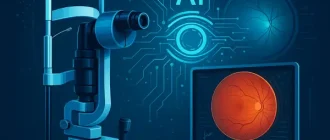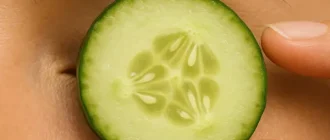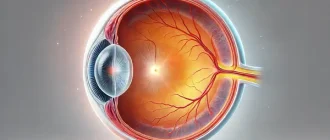Ocular tonometry is a diagnostic procedure used to measure the intraocular pressure (IOP) inside the eye. This test plays a key role in detecting glaucoma, a group of eye diseases that can lead to irreversible vision loss if not caught early.
Average Intraocular Pressure by Age Group
The chart shows the average intraocular pressure (IOP) measured in mmHg across different age groups. Notably, the pressure tends to peak in the 40s and then slightly decline with age. Data source: Nature Article.
Think of it as a blood pressure check, but for your eyes. Elevated eye pressure doesn’t always show symptoms, which is why tonometry is vital during routine eye exams—especially for adults over 40.
Why Eye Pressure Matters
Intraocular pressure is the force created by the fluid (aqueous humor) inside the eye. This fluid is constantly produced and drained through a small channel (the trabecular meshwork). When this drainage system becomes partially or fully blocked, pressure starts to build—slowly at first, then more aggressively.
An easy analogy: Imagine your eye as a kitchen sink with the faucet running. If the drain is working properly, the water flows out smoothly. But if it’s clogged, the water backs up and the pressure rises. That’s what happens with IOP—and the longer it goes untreated, the more stress it puts on the optic nerve.

The optic nerve functions like a high-speed internet cable transmitting visual data from the eye to the brain. Constant high pressure can “crush the cable,” damaging fibers over time. This process is irreversible and leads to vision loss, starting from the periphery.
Glaucoma is often called the “silent thief of sight” because it progresses slowly without warning signs. By the time central vision is affected, the damage is already advanced. Early detection through tonometry can save a person’s vision.
Distribution of Intraocular Pressure by Gender
The chart illustrates the average intraocular pressure (IOP) values by gender. Males show a slightly higher mean IOP (15.4 mmHg) compared to females (14.9 mmHg). Source: PMC Article.
Real Case: Man, 59, from Tucson, Arizona
During a routine check-up, this patient’s tonometry result was 26 mmHg. Follow-up tests confirmed early-stage open-angle glaucoma. Timely intervention with medicated eye drops helped preserve his vision. He now uses a home tonometer to monitor IOP weekly.
Real Case: Woman, 44, from Chicago, Illinois
She first noticed rainbow-colored halos around lights at night and frequent headaches. Attributing it to fatigue, she delayed her eye exam. During a sudden episode of eye pain and blurred vision, she visited an urgent care center, where IOP was recorded at 42 mmHg—an acute angle-closure glaucoma attack. Emergency laser treatment (iridotomy) relieved the pressure, and she now follows a strict monitoring routine.
Real Case: Man, 67, from Jacksonville, Florida
Diagnosed with hypertension 10 years earlier, this patient never connected his blood pressure meds to his eyes. His optometrist noted optic nerve cupping during a yearly exam, despite IOP reading in the “normal” range. Advanced diagnostics showed normal-tension glaucoma. He’s now on neuroprotective therapy and schedules twice-yearly tonometry.
These examples show that glaucoma doesn’t always present in the same way. Whether it’s silent buildup or acute onset, unchecked pressure puts vision at risk. Timely tonometry can be the difference between early control and irreversible damage.
Types of Tonometry and How They Work
| Type | How It’s Done | Accuracy (1–10) | Average Cost (USD) |
|---|---|---|---|
| Goldmann Applanation | A small probe touches the cornea after numbing; most widely used in clinics | 10 | $80–$150 |
| Non-Contact (Air Puff) | A puff of air flattens the cornea; no contact or drops needed | 7 | $40–$70 |
| Tono-Pen | A handheld device touches the cornea; portable and great for children | 8 | $60–$100 |
| Dynamic Contour | Uses a contoured tip to match eye shape; highly accurate | 9 | $120–$200 |
| Rebound Tonometry | A lightweight probe bounces off the cornea; no numbing drops required | 8 | $50–$90 |
Latest Innovations in Tonometry
Ocular diagnostics have entered a new era of convenience and precision. Here are some of the leading-edge innovations reshaping how we monitor intraocular pressure:
iCare HOME and iCare HOME2
Developed by Icare Finland, these devices enable patients to measure IOP at home. The iCare HOME2 offers cloud connectivity and automated data sharing with clinicians.
- Retail Price: ~$2,800 (iCare HOME2)
- Main Advantage: No drops, no puff, and easy for patients to use multiple times a day.
- Improved Experience: Empowers patients with self-monitoring, especially useful for those with fluctuating IOP.
Ocular Response Analyzer (ORA) by Reichert Technologies
This non-contact device assesses corneal biomechanical properties in addition to IOP, improving diagnostic accuracy for patients with thin or irregular corneas.
- Retail Price: ~$18,000–$25,000
- Use Case: Excellent in complex cases where standard tonometry is less reliable.
- Clinical Impact: Minimizes false positives/negatives in corneal-compromised patients.

Triggerfish Smart Contact Lens by Sensimed
Still under specialized use, this lens monitors IOP continuously over 24 hours and transmits data wirelessly.
- Use Case: Patients with suspected wide IOP fluctuation or difficult-to-diagnose glaucoma.
- Patient Benefit: Helps reveal pressure spikes that traditional methods often miss.
Tono-Vera by Reichert
A newer generation handheld tonometer offering automated positioning guidance and consistent readings.
- Price Range: ~$4,500
- Features: LED-guided alignment, minimal training needed.
- Advantage for Patients: Quicker, more reliable exams—especially beneficial in pediatric or community settings.
Market Adoption
According to the Global Tonometry Devices Market Report 2024, smart tonometry devices are growing at a CAGR of 5.8%. Clinics favor the iCare and ORA systems for their accuracy and ease-of-use. Meanwhile, home users appreciate the iCare HOME for its comfort and minimal learning curve.
What Patients Feel Now vs. Before
Older methods (like Goldmann) require numbing drops, eye contact, and trained hands. Newer options:
- Are painless and non-invasive
- Offer real-time feedback
- Can be used at home
- Involve no waiting rooms or unnecessary appointments
Bottom line? These innovations remove barriers and anxiety while improving early detection rates.
Who Should Get Tested?
Tonometry isn’t just for the elderly—it’s an essential test for anyone at increased risk of eye pressure abnormalities. Routine testing is recommended:
- Annually for adults over 40 — age significantly increases the risk of glaucoma.
- Every 1–2 years for individuals with a family history of glaucoma — especially if a parent or sibling has been diagnosed.
- Patients with systemic conditions such as diabetes, hypertension, or thyroid dysfunction—each of which can influence eye pressure.
- After significant eye trauma or surgery, including LASIK or cataract procedures, where structural changes may alter IOP.
- People using long-term corticosteroids, including nasal sprays and skin creams, as these medications can silently raise IOP.
- African American, Hispanic, and Asian populations over age 35—due to statistically higher susceptibility to certain types of glaucoma.
Prevalence of High IOP (>21 mmHg) in Children (15–18 years)
This chart represents the prevalence of high intraocular pressure (IOP over 21 mmHg) among children aged 15–18. The left eye shows a higher percentage (9.5%) compared to the right eye (6.3%). Source: ResearchGate.
Watch for These Symptoms
Even without visible signs, the following symptoms should prompt immediate tonometry:
- Persistent eye pain or pressure
- Seeing halos around lights
- Sudden onset of blurry vision or tunnel vision
- Frequent headaches localized near the eyes
- Unexplained nausea or vomiting (could signal acute angle-closure glaucoma)
Editor’s Tips
- Be proactive: If you experience any eye discomfort or visual changes, request a pressure check—even if your last exam was recent.
- Follow up: One abnormal reading isn’t a diagnosis. Your ophthalmologist may repeat tests at different times of day or across several visits.
- Reyus Mammadli, healthcare advisor, suggests making tonometry a staple in your annual check-up routine: “IOP can spike quietly. Being one step ahead is how you keep your sight intact.”
Are There Any Risks?
Tonometry is quick and low-risk. Some people may experience mild discomfort or eye redness. In rare cases, contact methods can trigger a slight corneal abrasion—but this heals quickly.
Tips Before Your Eye Pressure Test
- Avoid caffeine for at least 2 hours before the exam.
- Remove contact lenses unless advised otherwise.
- Try to relax—stress can temporarily spike IOP.
Editorial Advice
Reyus Mammadli, healthcare advisor, recommends getting your eyes tested annually even if you have no symptoms. “Glaucoma doesn’t knock—it just walks in. A 10-minute test can save a lifetime of sight.”
Investing in regular eye exams and being aware of your IOP is one of the smartest health choices you can make. If you’re tech-inclined, ask your ophthalmologist about home monitoring options.
Stay sharp—because your eyes deserve nothing less.
References
- American Academy of Ophthalmology. “Glaucoma: Diagnosis and Treatment.” 2024. https://www.aao.org
- Mayo Clinic Staff. “Glaucoma.” Mayo Clinic, 2023. https://www.mayoclinic.org/diseases-conditions/glaucoma
- National Eye Institute. “Facts About Glaucoma.” NEI, 2024. https://www.nei.nih.gov/learn-about-eye-health/eye-conditions-and-diseases/glaucoma
- Icare Finland. “iCare HOME2 Tonometer.” Product Page, 2024. https://www.icare-world.com
- Reichert Technologies. “Ocular Response Analyzer G3.” Product Brochure, 2024. https://www.reichert.com
- Sensimed AG. “Triggerfish Smart Contact Lens.” Clinical Overview, 2023. https://www.sensimed.ch
- Glaucoma Research Foundation. “Understanding Intraocular Pressure.” 2023. https://www.glaucoma.org
- MarketWatch. “Global Tonometry Devices Market Analysis and Forecast 2024–2029.” Accessed 2024. https://www.marketwatch.com
- Medscape. “Tonometry Techniques and Accuracy Comparison.” Updated 2024. https://emedicine.medscape.com
- Reyus Mammadli, Healthcare Advisor. Editorial contributions and clinical commentary, 2024.





